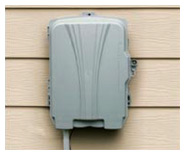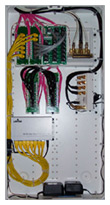The Fastest Speeds in the State.
Montana Opticom recognizes that discriminating homebuyers do not want yesterday’s technology in their new homes. That is why we have taken a very forward looking technology and delivered it to your home today. This community, while retaining the look of a traditional neighborhood, takes advantage of the latest fiber optic technology to provide you with the highest quality available in telecommunications systems today.
Right from the start, you can take advantage of this superior technology to access the Internet at the fastest speeds available in the industry. In fact, these speeds are dramatically faster than the Internet services offered to residential or business customers in any major metropolitan area.
Future Capable
With our fiber, you can be ensured of fast, superior service for years to come. While other offerings use technologies to force the Internet down an existing copper or coaxial infrastructure, limiting their future upgrade-ability, Montana Opticom uses brand new, state-of-the-art fiber optics, the limits of which are only now being explored.
Connection of Services:
 Each lot will have a distribution box at either the curb or on a back lot line. Install a 1 ¼ conduit (PVC or HDPE are acceptable) from the distribution box to the side of the house near the electrical meter. This duct or conduit will provide the path for fiber to be installed to the side of the home. Please note that this work is usually performed by the contractor that builds the home and is usually placed in a “joint trench” with the conduit for the electrical service. Since fiber optics is brought to the side of the house an electronic module is placed inside the enclosure or ONT (Optical Network Terminal) and this module requires power. Within 20 feet of the ONT that gets placed on the outside of the home, an Uninterruptible Power Supply (UPS) needs to be installed inside the home and a power cable run between them. Within 5 feet of the UPS an 110v receptacle needs to be installed. As most service locations are on the side of the garage and the garage usually has several power outlets, little if any rework will be required. A ground rod will also need to be located in close proximity to the ONT. Since all electrical service meter panels require that a ground rod be placed and we have the ability to attach to that same ground rod, little if any rework for this component will be required.
Each lot will have a distribution box at either the curb or on a back lot line. Install a 1 ¼ conduit (PVC or HDPE are acceptable) from the distribution box to the side of the house near the electrical meter. This duct or conduit will provide the path for fiber to be installed to the side of the home. Please note that this work is usually performed by the contractor that builds the home and is usually placed in a “joint trench” with the conduit for the electrical service. Since fiber optics is brought to the side of the house an electronic module is placed inside the enclosure or ONT (Optical Network Terminal) and this module requires power. Within 20 feet of the ONT that gets placed on the outside of the home, an Uninterruptible Power Supply (UPS) needs to be installed inside the home and a power cable run between them. Within 5 feet of the UPS an 110v receptacle needs to be installed. As most service locations are on the side of the garage and the garage usually has several power outlets, little if any rework will be required. A ground rod will also need to be located in close proximity to the ONT. Since all electrical service meter panels require that a ground rod be placed and we have the ability to attach to that same ground rod, little if any rework for this component will be required.
Please consult with a Montana Opticom engineer to ensure that the contractor / builder understand these guidelines. A properly terminated ONT and the associated power pack are pictured below:

Inside wiring:

 In order to take full advantage of the services available in this community it is very important to use a “Home Run” wiring architecture in your home. Home Run simply means this; one cable feeds one jack. It is the recommendation of Montana Opticom that structured cable be used (2-RG6 & 2-CAT5 in one cable) from each jack location back to the Home Run Media Panel. This will simplify the number of cables that must be installed. Voice and Data can both use Category 5 or better twisted pair cable.
In order to take full advantage of the services available in this community it is very important to use a “Home Run” wiring architecture in your home. Home Run simply means this; one cable feeds one jack. It is the recommendation of Montana Opticom that structured cable be used (2-RG6 & 2-CAT5 in one cable) from each jack location back to the Home Run Media Panel. This will simplify the number of cables that must be installed. Voice and Data can both use Category 5 or better twisted pair cable.
With the roll out of new video technology such as IPTV it is the recommendation of Montana Opticom that all perspective video locations be cabled with (2-RG6 & 2-CAT5 in one cable) from each jack location back to the Home Run Media Panel in order to take full advantage of the video features offered.
Typically all cables are run to the home run panel located in a utility room or garage where these cables are terminated and ultimately hooked together. Refer to the drawings below for an example of this style of wiring.
 There are a number of ways to terminate this cable in the wall depending on style required by the homeowner and the services that might be utilized at any given location. A sample outlet is shown and it is the recommendation of Montana Opticom that at a minimum, a single gang face plate be installed with all cables terminated such that any service can be utilized without having to rework the faceplate.
There are a number of ways to terminate this cable in the wall depending on style required by the homeowner and the services that might be utilized at any given location. A sample outlet is shown and it is the recommendation of Montana Opticom that at a minimum, a single gang face plate be installed with all cables terminated such that any service can be utilized without having to rework the faceplate.
Figure 1 (below) is a simplified plan of a small, two-bedroom, and single-story house. Note that all the wiring radiates from a single distribution device—the home run pattern—and there are multiple outlets in each major room, including the kitchen and the porch.

Figure 2 is a larger, two-story house, with a den that could well serve as a home office, again showing the home run wiring pattern. 
